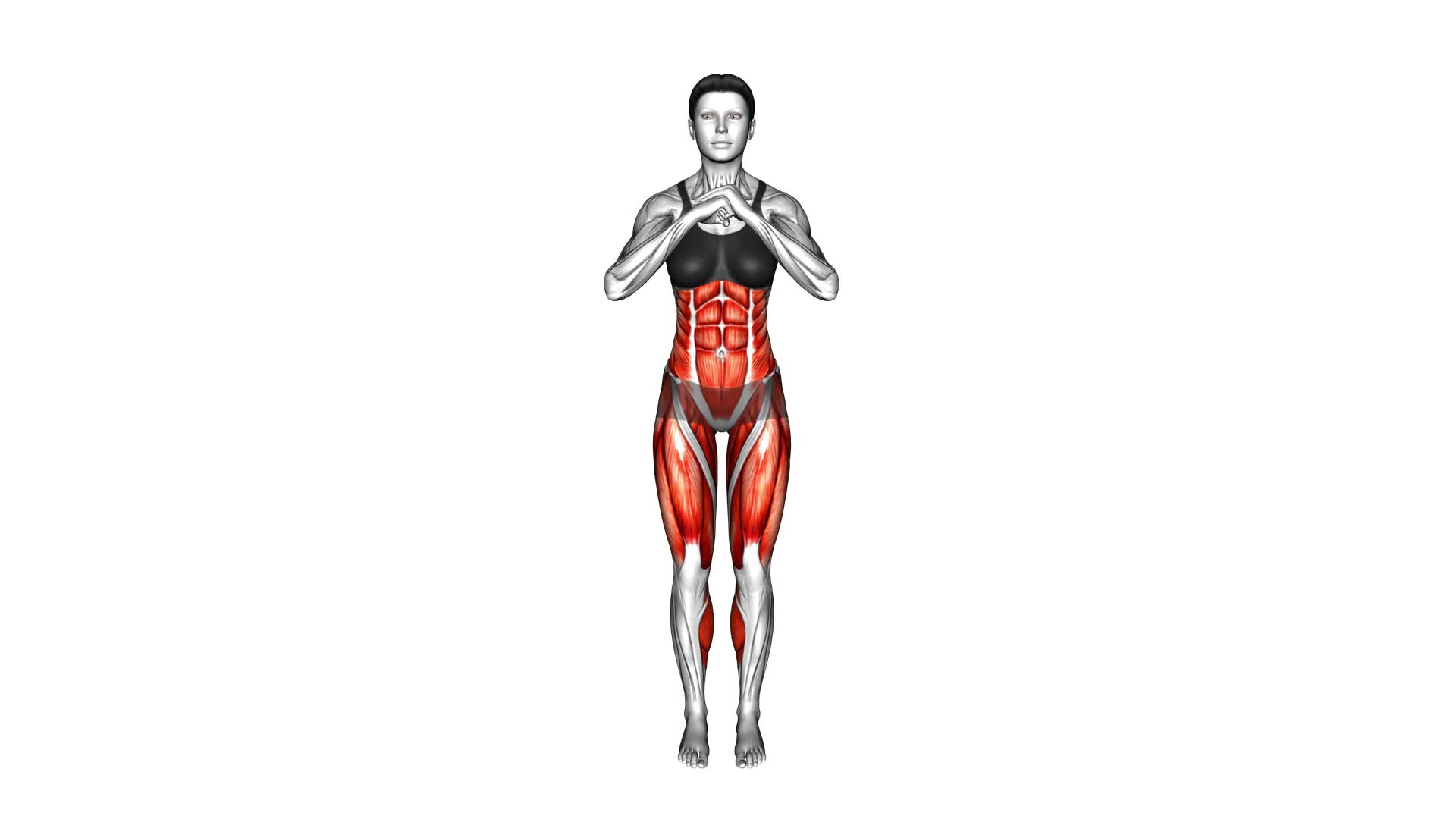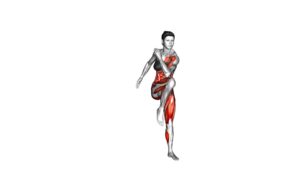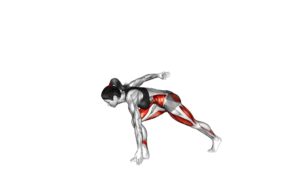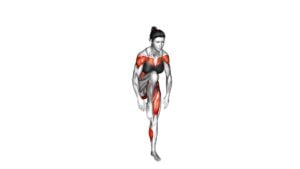Alternating Knee Thrust (female) – Video Exercise Guide & Tips

Get ready to tone your lower body with the Alternating Knee Thrust! This exercise targets your glutes, quads, and hamstrings, helping you achieve a strong and sculpted physique.
Watch This Exercise Video
In this video exercise guide, you'll learn proper form and technique, as well as modified versions for beginners and advanced variations for seasoned gym-goers.
Avoid common mistakes and maximize your results with these expert tips.
Let's get started and take your fitness to the next level!
Key Takeaways
- The alternating knee thrust exercise strengthens core muscles and improves stability, posture, balance, and coordination.
- There are modified versions of the exercise for beginners, such as starting with hands on an elevated surface or bending the knees instead of straightening the legs.
- Advanced variations of the knee thrust include plyometric knee thrusts, weighted knee thrusts, and single-leg knee thrusts, which can help increase strength and endurance.
- It is important to avoid common mistakes, such as using momentum instead of controlled movements, maintaining proper alignment of hips and shoulders, and engaging the core and glutes throughout the exercise. Additionally, it is important to warm up before performing the exercise and listen to your body to prevent injury.
Benefits of the Alternating Knee Thrust
One benefit of the Alternating Knee Thrust is its ability to strengthen your core muscles. This exercise specifically targets your abdominal muscles, obliques, and lower back. By engaging these muscles, you can improve your overall stability and posture. Additionally, the Alternating Knee Thrust helps to enhance your balance and coordination. As you lift your knees towards your chest while maintaining a stable position, you're training your body to stay centered and controlled.
The Alternating Knee Thrust also offers variations that allow you to intensify or modify the exercise based on your fitness level and goals. For instance, you can add resistance by holding a dumbbell or kettlebell while performing the exercise. This will increase the challenge and further engage your core muscles. Alternatively, if you're a beginner or have difficulty with balance, you can perform the exercise with your hands on a stable surface such as a bench or step. This modification provides additional support and stability while still targeting your core muscles effectively.
Now that you understand the benefits and variations of the Alternating Knee Thrust, let's move on to discussing proper form and technique.
Proper Form and Technique
To ensure proper form and technique during the Alternating Knee Thrust exercise, it's important to maintain a stable position and engage your core muscles throughout the movement. Here are some key points to keep in mind:
- Stable Position: Start by standing with your feet shoulder-width apart and your knees slightly bent. Keep your back straight and your shoulders relaxed. This will help you maintain balance and stability throughout the exercise.
- Engage Your Core: As you lift your knee towards your chest, focus on engaging your core muscles. This will help stabilize your body and prevent any unnecessary movements or swaying.
- Proper Breathing Techniques: It's important to maintain a steady breathing pattern during the exercise. Inhale as you lower your leg back to the starting position, and exhale as you lift your knee towards your chest. This will help you maintain control and stability throughout the movement.
Common misconceptions to avoid include using momentum to swing your leg up, which can put strain on your lower back, and allowing your upper body to lean forward or backward. Remember to maintain proper posture and control throughout the exercise for maximum effectiveness and safety.
Modified Versions for Beginners
If you're new to the Alternating Knee Thrust exercise, there are modified versions available for beginners that can help you ease into the movement while still engaging your core and building stability. These beginner modifications are designed to help you gradually build strength and improve your overall fitness level.
One modification you can try is to perform the exercise with your hands on an elevated surface, such as a bench or step. This will decrease the amount of weight you have to support and make the exercise more manageable. As you become more comfortable, you can gradually lower the height of the surface until you're able to perform the exercise on the floor.
Another modification is to perform the exercise with your knees bent instead of straightening your legs. This reduces the amount of strain on your lower back and allows you to focus more on engaging your core muscles. As you get stronger, you can gradually begin to straighten your legs and increase the difficulty of the exercise.
Remember to start with a weight that's appropriate for your fitness level and gradually increase the intensity as you become stronger. It's important to listen to your body and only push yourself as far as you feel comfortable. With consistency and dedication, you'll be able to progress to the full version of the Alternating Knee Thrust exercise in no time.
Advanced Variations for Seasoned Gym-goers
Challenge yourself with advanced variations of the Alternating Knee Thrust exercise to take your workout to the next level. These advanced knee thrust variations will push your limits and help you achieve greater strength and endurance.
Here are three advanced gym exercises you can try:
- Plyometric Knee Thrusts: Incorporate explosive movements into your knee thrusts by adding a jump. Start in a low lunge position with one knee bent and the other leg extended behind you. Explosively switch legs, jumping off the ground and bringing the bent knee forward while extending the other leg back. Land softly in the lunge position and repeat on the other side. This plyometric variation adds a cardiovascular component to the exercise, increasing your heart rate and calorie burn.
- Weighted Knee Thrusts: To make the knee thrusts more challenging, add extra resistance by holding a dumbbell or kettlebell in each hand. This added weight will engage your muscles even more, helping you build strength and definition in your lower body.
- Single-Leg Knee Thrusts: Take your knee thrusts to the next level by performing them on a single leg. Balance on one leg and bring the opposite knee up towards your chest. This variation requires greater stability and strengthens your core and hip muscles.
Incorporate these advanced knee thrust variations into your workout routine to continue challenging yourself and achieving your fitness goals.
Common Mistakes to Avoid
When performing the Alternating Knee Thrust exercise, be mindful of the common mistakes that can hinder your progress. These mistakes can prevent you from getting the full benefits of the exercise and may even lead to injury.
One common mistake is using momentum instead of controlled movements. This can reduce the effectiveness of the exercise and put unnecessary strain on your muscles. To improve your technique, focus on slow and controlled movements, engaging your core and glutes throughout the exercise.
Another mistake to avoid isn't maintaining proper alignment. Ensure that your hips and shoulders are squared and facing forward throughout the movement. This will help target the correct muscles and prevent any imbalances or strain on your joints. Additionally, be cautious not to let your knees collapse inward as you perform the exercise. Keep them in line with your hips to avoid any unnecessary stress on your knees.
Lastly, it's important to avoid holding your breath during the exercise. Instead, remember to breathe regularly and exhale as you drive your knee forward. This will help you maintain proper form and prevent any unnecessary tension in your body.
Tips for Maximizing Results
To maximize your results with the Alternating Knee Thrust exercise, focus on maintaining proper form and engaging your core and glutes throughout the movement. Here are some tips for maximizing your results:
- Maximizing Intensity: To maximize the intensity of this exercise, focus on controlling the movement and performing it with a slow and controlled tempo. This will help you engage your muscles more effectively and increase the challenge for your core and glutes.
- Incorporating Resistance Training: To further maximize your results, consider incorporating resistance training into your routine. You can do this by using ankle weights or resistance bands to add extra resistance to the exercise. This will help you build strength and increase the difficulty of the exercise.
- Varying the Range of Motion: To challenge your muscles in different ways and maximize your results, try varying the range of motion of the exercise. You can start by performing the exercise with a smaller range of motion and gradually increase it as you get stronger. This will stimulate your muscles in different ways and help you achieve better overall results.
Frequently Asked Questions
How Many Calories Can Be Burned by Doing the Alternating Knee Thrust Exercise?
When you do the alternating knee thrust exercise, you can burn a significant number of calories. This exercise is a great way to get your heart rate up and increase your metabolic rate, leading to calorie burn.
It's important to note that the number of calories burned will vary depending on factors such as your weight, intensity, and duration of the exercise.
Additionally, incorporating a warm-up before doing this exercise is important to prevent injury and prepare your body for the workout.
Is It Necessary to Warm up Before Performing the Alternating Knee Thrust?
It's important to warm up before performing the alternating knee thrust. Warming up helps increase blood flow to the muscles, preparing them for the exercise. It also helps prevent injuries and improves overall performance.
To perform the alternating knee thrust correctly, start in a plank position, engage your core, and bring one knee towards your chest while keeping your back straight. Alternate legs and repeat for the desired number of reps.
Can the Alternating Knee Thrust Help in Reducing Belly Fat?
Yes, the alternating knee thrust can help in reducing belly fat.
By engaging your core muscles and increasing your heart rate, this exercise can contribute to overall fat burning.
It targets the abdominal muscles, helping to tone and strengthen them.
Additionally, the alternating knee thrust can be modified for beginners by performing the exercise at a slower pace or with less intensity.
Variations of this exercise include adding weights or performing it on an unstable surface for an extra challenge.
Are There Any Specific Muscles Targeted by the Alternating Knee Thrust Exercise?
The alternating knee thrust exercise targets specific muscle groups in your body. It engages your core muscles, including your abs and obliques, helping to strengthen and tone them.
Additionally, this exercise also works your hip flexors and quads, contributing to improved lower body strength.
How Frequently Should the Alternating Knee Thrust Be Incorporated Into a Workout Routine for Optimal Results?
To get optimal results from the alternating knee thrust, it's important to incorporate it into your workout routine regularly. By doing this exercise frequently, you'll see improvements in your lower body strength and stability.
Remember, proper form is key to avoid injury and maximize the effectiveness of the exercise.
To add more challenge, you can try variations like holding dumbbells or adding a jump at the top of the movement.
Keep pushing yourself for better results!
Conclusion
In conclusion, the alternating knee thrust is an effective exercise for strengthening the lower body and core muscles.
By following proper form and technique, beginners can gradually progress to advanced variations.
Avoiding common mistakes and implementing tips for maximizing results will help achieve desired outcomes.
Incorporating this exercise into a regular workout routine can lead to improved muscle tone and overall fitness.

Author
Years ago, the spark of my life’s passion ignited in my mind the moment I stepped into the local gym for the first time. The inaugural bead of perspiration, the initial endeavor, the very first surge of endorphins, and a sense of pride that washed over me post-workout marked the beginning of my deep-seated interest in strength sports, fitness, and sports nutrition. This very curiosity blossomed rapidly into a profound fascination, propelling me to earn a Master’s degree in Physical Education from the Academy of Physical Education in Krakow, followed by a Sports Manager diploma from the Jagiellonian University. My journey of growth led me to gain more specialized qualifications, such as being a certified personal trainer with a focus on sports dietetics, a lifeguard, and an instructor for wellness and corrective gymnastics. Theoretical knowledge paired seamlessly with practical experience, reinforcing my belief that the transformation of individuals under my guidance was also a reflection of my personal growth. This belief holds true even today. Each day, I strive to push the boundaries and explore new realms. These realms gently elevate me to greater heights. The unique combination of passion for my field and the continuous quest for growth fuels my drive to break new ground.







